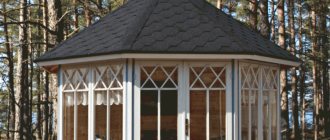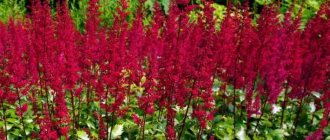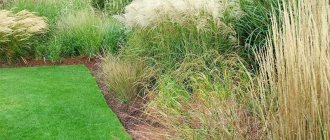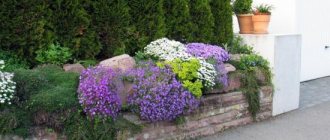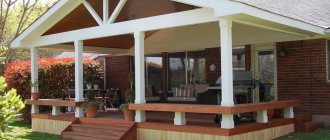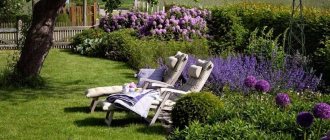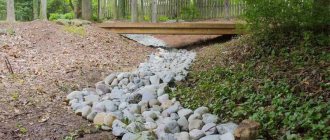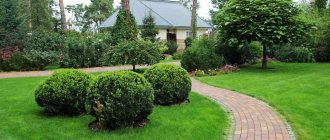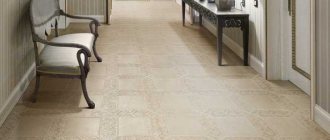The decoration in the form of a dried up stream bed will add a touch of romance and wildlife to the monotonous landscape. Unlike an alpine hill, which has a similar aesthetics, a dry stream in a country house or near a house can also have practical significance. If you build it along the path of communications, electrical wiring or water supply, you can provide easy access, especially to the joints, if repairs are necessary.
With skillful planning, you can combine a decorative effect with drainage, which removes excess moisture from cultivated areas of land.
A little history
The dry stream is the grandson of the ancient stone gardens of the Land of the Rising Sun. The gardens themselves were designed to decorate the not very fertile soils of the island state and teach us to appreciate the beauty of nature even in such an unusual version for us.
In addition, such artificial structures were designed to develop imagination, distract from everyday worries, and immerse themselves in self-knowledge.
Gradually, the unusual idea migrated to Europe and Russia, where a dry stream in landscape design performs a purely decorative function, without any secret meaning.
By the way, in a large area you don’t have to limit yourself to creating just a stream; some housewives manage to make entire rivers and even lakes out of stone.
History of origin
Dry stream is nothing more than an interpretation of Japanese stone gardens. It's no secret that the Japanese (like all residents of the East) are very scrupulous in matters of attitude towards nature. It is an important part of spiritual life, and it is no coincidence that it is in the open air that it is recommended to carry out various spiritual practices and meditate. It is likely that stone gardens were created for these purposes, of which dry streams were an essential component.
Today, anyone can use a waterless stream for landscaping.
Looking at a dry riverbed, a person can imagine how after some time it will fill with water and turn into a stormy river. According to psychologists, such a pastime is very useful for emotional and spiritual recovery. This allows you to analyze your actions and find the right solution to serious problems.
The stream can be easily done with your own hands - you don’t even have to hire specially trained people.
After some time, stone gardens began to appear in the West, and, relatively recently, they found their use in Russia.
If you have imagination and imagination, you can easily build such a decoration in your garden.
Benefits of a dry stream
Compared to its natural counterpart, a dry stream has many advantages. Similar creation:
- does not require desilting or the use and maintenance of special pumping equipment;
- does not emit the unpleasant odor of standing water;
- does not become a habitat for mosquitoes and midges;
- absolutely safe for kids.
Such a decoration will easily fit into any area, can serve as a beautiful and unusual decor or an elegant separator of two functional zones, and will cover up uneven areas, drainage channels and laid hoses.
Dry stream
My garden itself dictated to me not only where and what to plant, but also to build or build. It just so happened. I didn't have any plans or projects. At least it wouldn't hurt. Dreams turned into ideas that came naturally. All that remains is to choose a way to implement them and get to work.
So it was with the idea of making a dry stream instead of an alpine hill. After the construction of the well, a mound was formed at its base with an arched depression at its base. And a little further from it there was a place where our wonderful builders poured out crushed stone for construction. The ground there became difficult to dig. I had to take the path of least resistance and, in order not to pick out small pebbles from the ground, create a dry stream there. So I lived with these dreams for five years - I just couldn’t dare to start making them come true. I really didn’t want to create something like kitsch, a parody. The picture was spinning in my head, but there was nowhere to look at an example of a decent dry stream, as well as a good rock garden in real life. But one day I really wanted to make my dream a reality, my hands were so itchy that I took the courage and got to work. My dream was to make a closed cycle for a real stream with a pond, but somehow the materials didn’t work out. So I decided not to wait any longer. She deepened the bed of the future stream, poured sand and laid a thick construction film there. Then I laid out the largest boulders. If you look in the direction of flow of water in the stream, the right bank turns out to be steep, “rocky”, and the left bank is flat and rather resembles a rocky scree. There are no large stones on it; they are all concentrated on the right bank. I poured crushed stone onto the laid film. Then, closer to the “shores,” she laid small stones. Some were laid so that it seemed that it was a large stone, but it cracked, filled with small rubble and soil, and plants settled there. This photo, taken 5 years later, clearly shows how the stones were laid.
At the top of the stream there is a large stone with a small step. There is a smaller stone on it. You can run a hose under it and turn on the water. It turns out very beautiful. Water gurgles over the pebbles, falling from the first large stone in a small waterfall. Ideally, for my case, it would be necessary to lay a pipe under the stream bed, under the film, connecting the reservoir and the head stone at the top of the stream. The flowing water from the reservoir would be pumped upward and flow back into the reservoir.
In some places I placed larger stones in the middle of the riverbed. After all, this happens in nature. :) The stream meanders around these stones. The gaps between the large stones on the right bank were filled with rubble and the young were settled there.
ate cushion-shaped
juniper and Konika spruce, and in the foreground on the left are bergenia. There, on the top of a large stone in front of the juniper, in addition to the young ones, cinquefoil, thyme, lumbago also grow, hiding spring bulbs underneath.
Blue spruce grows behind the cushion spruce. She is many years old, but she is growing very slowly.
In autumn and spring, the bright foliage is offset by the greenery of spirea needles. One of them has lemon-yellow leaves in spring, the other has bronze leaves.
At the bottom of the stream, near the reservoir, a red currant perched on a trunk. But she doesn’t really like something there. I’ll feed her this year.
But she doesn’t really like something there. I’ll feed her this year.
And this is autumn. From this angle, the stream looks a bit like a mountain landscape on a scale 
Now it’s very easy to make this dry stream real, babbling. But honestly, I like dry better. And sometimes the rains revive it and that’s enough for me.
Another tip: try to ensure that there are no plants along the banks that scatter seeds or small leaves in the fall. I have a sedum that has taken up residence, I have been fighting it for three years now, but it keeps sprouting and sprouting. And it’s very tedious to remove leaves from rubble. I wanted to plant a Matsuda willow next to the stream, but I just imagined how many small yellow leaves there would be in the fall... And it would be beautiful.
Crushed stone should not be left uncleaned, especially in the fall - small plant debris will turn into nutrient soil and there will be no appearance. The only thing that saves me is a garden vacuum cleaner. Although, probably, if you have a regular vacuum cleaner that can blow out air, then you can use it to blow away all the small debris. Ideally, in cool mansions, the rubble is removed annually, washed or new is poured.
Types of dry streams
Like natural streams, dry imitations can be:
- winding, making their way through obstacles in the form of bushes, trees, beds or flower beds;
- branched, creating the feeling of several channels, each of which can be designed in a completely unique way;
- a waterfall that will perfectly improve the uneven terrain;
- a lake enriched with water lilies or herons.
The design of dry streams has no clear rules, so it can make any dream of its owners come true. The location for the stream can be chosen completely arbitrarily.
However, it is better if the source is located on a slight hill. If the area is a flat surface, then make a small hill or hide the beginning of the stream in the bushes. The mouth can be hidden near the fence or arranged as a small lake.
Kinds
Dry streams can be of 3 types. They vary in level of complexity, design features, and “flow” trajectory. This division is very arbitrary. When creating one decorative object, techniques characteristic of each of the listed techniques are often used.
Winding
Projects in this category have a fairly simple design. There should be one channel, the width of the stream changes throughout the entire course. The flow can go around “islands”, stop in “backwaters”, and wind through thickets. Such dry reservoirs look good on summer cottages, which are distinguished by their impressive width.
Ramified
This composition is considered difficult. The master needs to think through everything carefully at the preparation stage. Not only the appearance of the finished object, but also its service life depends on how its actions are planned.
When selecting material, it is necessary to take into account climatic conditions and soil characteristics. Artificial flows that have different origins diverge, converge, and intersect. This is how they frame garden sculptures, flower beds, and a recreation area.
Waterfall
The bed of the cascade composition is placed on a hill. The main stream is constructed from boulders and sandstone. To create the appearance of a smooth surface, flat stones are laid. They can be placed either far from each other or close to each other.
Materials
To make an original garden decoration you will need;
- small stones for the riverbed;
- larger boulders to create banks;
- sand for outlining the boundaries of creation and pillows;
- plants for planting on the sides of a stream or creating green islands;
- decorative elements.
Stones
The most expensive material will be stones. To create the stream itself, you can purchase:
- river pebbles;
- gravel;
- crushed stone;
- marble chips.
They are used individually or combined with each other. At the same time, lighter colors are used for the “shoals”, and the pools are decorated with dark pebbles. Gray pebbles will create a feeling of light flow (you can also lift the pebbles with a rake, creating a wave effect), small boulders with crushed stone laid in a circle will create “whirlpools”.
Blue or dark blue pebbles will help you achieve a complete resemblance to water. If it is not possible to buy such material, you can simply paint the stones in the desired colors. At the same time, glossy paint or varnish will create interesting shimmers in the sun. Colored glass or glass balls are used as original decorations.
Large stones are represented by ordinary cobblestones, basalt, tuff, and limestone.
Plants
They try to decorate a dry stream at the dacha with their own hands, the photo of which shows the charm of its unusual design, with plants, giving additional naturalness. Low ones are ideal for plantings:
- velvets;
- lobelia;
- saxifrage;
- hosts;
- spicy and ornamental herbs.
An abundance of green spaces or too tall plants can destroy the beauty of a stream or lake.
Decor
Decorative elements will add additional charm to the man-made creation.
A dry stream with a bridge looks great; the shallows are decorated with artificial lilies, frogs, animal figures, and lanterns. A decorative mill or bench is placed on the bank, and a gnome's house is erected at the source.
At the same time, the decor should not interrupt the created stream. Therefore, you should not get too carried away with decorating your creation.
Creating banks
Larger stones are placed on the boundaries of the resulting stone flow, forming the banks of the creation, or plants and flowers are planted. Representatives of the flora can also be planted between boulders.
However, it must be remembered that too tall plants can destroy all the beauty of a man-made stream. Most often, small plants are used here: marigolds, saxifrages, hosts, daylilies, and lobelias.
Creating a stream
When all the necessary elements have been purchased and selected, you can begin work on creating an original decoration.
Making a dry stream with your own hands step by step is not particularly difficult, so even inexperienced owners of a plot of land can create it.
- Step 1. Channel planning. The boundaries of the future creation are outlined with sand. This material is clearly visible on the ground, and the border can be easily moved to another location. To give authenticity, the riverbed is made of different widths and gently curved around obstacles.
- Step 2: Removing the soil. The riverbed will need to be deepened a little. To do this, soil is selected from the delineated area. Ten to fifteen centimeters is enough; a deeper channel will not look entirely natural.
- Step 3. Sand filling. Geotextiles are laid at the bottom of a shallow trench (ordinary polyethylene film is also suitable), and a layer of sand is poured onto it. This simple covering will help control weeds. If the stream is planned as a drainage ditch, polyethylene is not laid.
- Step 4. Laying stones. Large stones will represent the banks of the stream; they are laid first, just like the “thresholds”. The riverbed is covered with small stones, trying to avoid open spaces. In this case, stones can creep on top of each other, creating small hills and whirlpools.
- Step 5. Decoration. Plants are planted along the banks; a couple of flowers can be planted inside the stream, carefully moving the stones apart and pouring in fertile soil. Installing decorative elements will complete the creation.
Self-installation
There is nothing difficult in making a dry stream on the site with your own hands, if, of course, you treat the matter with the utmost care and allocate a sufficient amount of time.
Preparation
Before proceeding to the formation of a dry stream composition, it is necessary to determine its size, shape, color and materials.
The first 2 indicators are selected based on the area of the site. For example, if the territory is narrow and long, then an imitation of a dry lake will look better on the site. It is best to decorate a short and wide area with a winding stream, which will visually lengthen the area. Moreover, for correct perception, the width of the flow should not be more than 1 meter and less than 30 cm.
The location for laying the stream is also an important component that should be paid close attention to. In general, you can arrange such landscape decoration anywhere, be it in front of the house, in the garden or in the backyard. The source is placed both on a hill and on a plain. If desired, you can create a dry stream that will zone the area when divided. The object will fit perfectly into the area along the path.
The most commonly used materials for creating a dry stream are pebbles and gravel. You can purchase them at the construction market. If the project requires it, the material can be painted with water-repellent paint of any color in order to fit well into the overall style of the site. Thus, small blue pebbles will resemble a real body of water from afar.
If the budget is not strictly limited, then it is quite possible to use basalt and slate for decoration in gray-blue tones. If you dilute the finished riverbed with splashes of glass beads, then when exposed to sunlight, the stream will sparkle with interesting colors.
If you plan to move away from the classical understanding of a stream and create a red-brown stream, granite, marble or limestone is used for decoration.
To create accents, large stones are used, between which pebbles are installed.
Once it has been decided where the stream will be located and what it will look like, it will be useful to capture this on paper in the form of a sketch, so as not to go astray in the future and complete the landscape object in accordance with the creative plan.
Laying stones
Installation of a dry stream begins with marking and preparing the surface. Thus, the boundaries of the future stream are outlined with sand or highlighted with a rope. These contours are used to dig a trench along them about 15 - 30 cm deep. Do not make it too deep.
The bottom of the trench is thoroughly leveled and compacted. Geotextiles are laid on top - a material that will prevent the growth of plants and the deepening of the trench after the creation of a dry stream.
Next, you can proceed to the actual laying of stones. They begin by decorating the banks with large cobblestones. Smaller stones are placed in chaotic order in the crevices. After the banks, the stream itself is created as the imagination requires.
If necessary, a dry stream is decorated with stones painted in different colors. You can even arrange lighting so that in the dark the stream plays with colors and gives the area a touch of romance and mystery.
Important! The stones are laid only in the most natural order possible, so that no one even thinks that the stream was created artificially.
Care
A properly maintained stream will not require much effort to care for it. It will be enough to trim the grass on the bank and weed the plants.
In hot weather, the stones will have to be watered so that they do not dry out the ground around too much. High humidity can lead to the appearance of moss, so the stones will have to be turned over occasionally.
Ants may choose a stream as a new home, so it will need to be periodically sprayed with special products.
A nice design will help to decorate the area in an original way and cover up not the most beautiful places, causing the white envy of neighbors and passers-by.
Step-by-step instructions for creating a dry stream with your own hands
The process of creating an artificial flow is not complicated. Following a clear algorithm, you can decorate the territory yourself.
The procedure should be as follows:
- Choosing a location.
- Determining the required parameters.
- Selection of materials.
- Creating a sketch.
- Design of contours.
- Preparation of the riverbed.
- Laying stones.
- Decorative design of the composition.
Construction of the pit begins after purchasing materials. To make a channel, you need:
- The selected area is cleared of weeds.
- Dig a trench along the lines outlined by the sand. Its depth is at least 30 cm.
- Compact the base.
- Lay geotextiles. It will prevent the grass from sprouting.
The stones are laid in a certain order. At first the coastline is made of cobblestones, later they will act as a support. Then they begin to form thresholds. At this stage you will need flat stones of a light shade. Stone chips and small pebbles are poured between them.
Important! The pit of a dry stream, which is planned to be used as a drainage system, is not covered with geotextiles. The stones will have to be secured with concrete mortar.
Photo ideas of dry streams in the landscape design of a dacha
Thinking through the design
We have already noted that the arrangement of a dry stream in landscape design can be very diverse. This depends on the climate (you will have to choose plant varieties based on weather conditions) and on the area used for decoration.
A dry stream of stones must be designed so that the imperfections of the relief are not noticeable. For example, if you make it narrow and winding, you can visually make this area deeper and increase the area of the garden plot. To imitate water, use small stones of a dark shade, and to create unique thresholds, choose lighter and larger elements.
If you plan to create a decorative dry stream in a soft blue color scheme, choose basalt, slate or gneiss. A dry stream in the garden in a green or red-brown palette can be decorated with granite pebbles.
Using certain types of stones you can create lighter or darker accents. For example, the expressiveness of white color is emphasized by marble or limestone details. And you can create a shimmering effect by adding glass-based balls or stones to the design of dry streams.
Tip: depending on the materials used, decide what you can use to paint the stones for a dry stream in order to diversify the color scheme of such an area.
Interesting dry stream ideas are created by adding floral details. This could be a central island of flowers or individual accents throughout the entire area of the stream. We advise you not to use many bright colors at once for a dry stream, but to choose options that will harmoniously complement each other and the other elements.
The most successful option is flowers with bluish tints. Plant bluebells, bearded irises, fescue or mosquito grass in the area of your homemade stream. Flower beds can be made in several tiers.
Plants for a dry stream: photos, with names
To make a dry stream design look realistic, consider companion plants that evoke associations with water features. For example, as additional plants for a dry stream, you can take plants with the following names: miscanthus, reed arundo, Chinese reed.
The next interesting idea is a dry stream with a bridge. It is made from a solid natural block or log. A bridge for a dry stream is most often chosen when such decor takes up a lot of space. This object will emphasize the realism of your idea and create the appearance of crossing a real body of water.
You can also create an imitation of crossing through rushing water using large pebbles on the surface of such a stream.
Bridge over a dry stream, photo
Tip: look at examples of the design of a dry stream with a bridge and a mill: such a composition will make your site even more attractive.
When planning elements for a dry stream, focus on how harmonious they will look with the existing objects on the site. It is important that the natural landscape is combined with the materials in your dacha or emphasizes a single style. By the way, a dry stream can serve as an element of zoning the territory of your site, and with partial isolation it can be supplemented with details that will distinguish the recreation area from the rest.
There are many more options for decorating a dry stream. For example, place street lamps or benches for relaxation nearby. And in some places you can place figurines of frogs, storks and other representatives of the fauna that approach water bodies.
